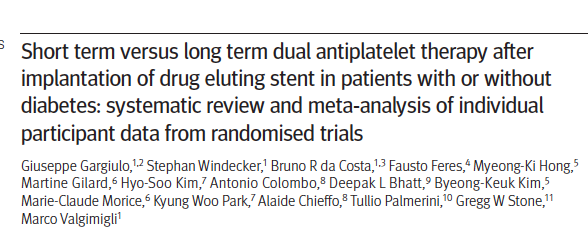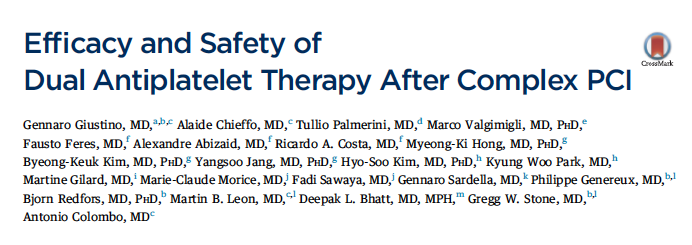Dual antiplatelet therapy (DAPT) is considered standard treatment after percutaneous coronary intervention (PCI) accompanied by stent deployment. The optimal duration of DAPT after a drug eluting stent (DES) remains controversial. Six months of DAPT is the minimum duration recommended by all professional cardiology guidelines with a DES implantation.
Diabetes is associated with increased platelet and thrombin reactivity and decreased response to treatment. Diabetes is well known to trigger atherosclerosis and restenosis after PCI. It is unclear whether diabetes mandates a different protocol in DAPT duration. It has been suggested that patients with diabetes may require prolonged DAPT.
Some trials have demonstrated that short term (up to 6 months) DAPT is not in any way inferior to 12 months treatment. A recent meta-analysis of individual patient data from 6 randomized trials compared outcomes between short term (3-6 months) DAPT and long term DAPT (> 12 months) after DES placement in 11,500 patients (BMJ 2016;355:i5483). One third of these patients had diabetes and mean age was 63 years.
The one-year outcomes were: –
Incidence of major cardiovascular events (MACE) was higher in diabetics than in non-diabetic patients 9hazard ratio 2.3)
Incidence of MACE was not lower with long term DAPT than short term DAPT in both diabetics and non-diabetics.
Rates of major and minor bleeding were significantly higher with long term DAPT in patients with diabetes (HR 1.9).
Rates of major and minor bleeds were significantly higher with long term DAPT in patients without diabetes (HR 2.6).
According to the researchers patients with diabetes were at higher risk for ischemic events compared to non-diabetics after PCI with DES. But there was no benefit with prolonged DAPT in both diabetics and non-diabetics.
Bare metal stents (BMS) results have been bettered by DES regarding risk of restenosis and repeat revascularization but DES carry the risk of increase in late and very late stent thrombosis (ST). First generation DES were associated with 4-5 fold higher risk of ST than BMS. This led to the advocacy of long term DAPT in the hope of preventing or reducing ST. Prolonged DAPT however can lead to increased bleeds, death and costs.
The researchers discuss that their study shows long term DAPT does not provide ischemic protection but rather raises the risk of bleeding regardless of diabetes status. Even patients of diabetes on insulin did not stand to benefit with long term DAPT. Almost two thirds of patients included in the meta-analysis had stable angina.
Future studies must be designed to confirm optimal duration of DAPT in diabetic patients.
Complex PCI defined as 3 vessels treated; 3 stents implanted; 3 lesions treated; bifurcation with 2 stents implanted; total stent length >60 mm and chronic total occlusion (CTO) has significantly higher MACE at 1 year than those without, including cardiac death (2.0% vs. 1.3%, p=0.009). Long term DAPT was associated with lower MACE in complex lesions as compared to short term DAPT (hazard ratio 0.56); but bleeding was increased (J Am Coll Cardiol 2016; 68:1851-64).
The above results were derived from another meta-analysis that included 6 randomized control trials. Of 9,577 patients included, 1680 (17.5%) underwent complex PCI. Almost 85% of patients received new generation DES. Complex PCI patients had higher rates of MACE and long term DAPT significantly reduced MACE in the complex PCI group.
The rationale for DAPT subsequent to PCI with DES is based on preventing stent related thrombotic complications while vascular healing and endothelialization are ongoing; a process that lasts from 1 to 6 months with new generation DES. Long term DAPT (1 year or more) significantly reduced the risk of cardiac ischemic events and this effect was greater with procedural complexity. Hence complexity of coronary anatomy is an important parameter to consider when deciding duration of DAPT.
DAPT will have to be individualized with long term therapy in complex PCI, diabetic patients with complex PCI and patients with acute coronary syndrome.

